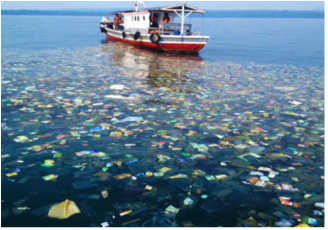 Bryce Cullen Staff Writer Our oceans are currently facing the greatest plague ever, and sadly, we are the sole cause of all of its destruction. At the rate we are increasing our plastics in the oceans fish and mammals have had to deal with this for years now, and it continues to get worse. The United Nations estimates that the plastic kills about one million marine organisms every year although they still consider this to be a great underestimate as to the true amount of marine animals the plastic kills. If we do not change our ways, this can cause catastrophic damage for people from all walks of life. The area most affected is called the Great Pacific Garbage Patch. It is hard to believe just how much plastic and micro plastics collect in that area. It is said that the Great Pacific Garbage Patch is the size of Russia. When Russia is one of the largest countries in the world, we should know we have a major problem. Although little is being done to help, a recent study reveals that in the United States we only recycle about 9% of all our plastics. Another study from the Ellen MacArthur Foundation estimates that 311 million tons of plastic were created in 2014. They have even said that this number will double within the next twenty years. Their predictions show that the amount of plastics in our oceans will equal the amount of fish in our oceans, with a plastic to fish ratio being 1:1. Plastic is known to be a very durable material, so when it comes in contact with our oceans, it is not going anywhere anytime soon. However, one way it does break down is through increasing heat. That being said, when the sun is in constant contact with these plastics it allows them to break down into something called micro plastics. This makes cleanup efforts much more difficult, and if ingested, it creates health problems. Specialists at London’s Brunel University studies have shown that a quarter of fish sold within California and Indonesia contain plastic. This Plastic Plague is now even affecting our seafood supply. Californian oceanographer Captain Charles J. Moore stated, “Plastics is in the air we breathe, it’s become part of the soil and the animal kingdom. We’re becoming plastic people.”
These are only a few of our very many environmental worries. If we do not change the way we manufacture and produce things, then we have an even bigger list of problems to only add to our current ones. It does not take much to help it is a simple as purchasing a refillable water bottle and throwing your plastic water bottle into the recycle bin rather than the trash. If we can all do our part and begin with baby steps, then maybe we can be looking towards a brighter future, rather than a plastic one. Comments are closed.
|
Archives
March 2017
Categories
All
|

